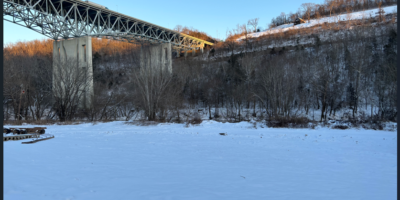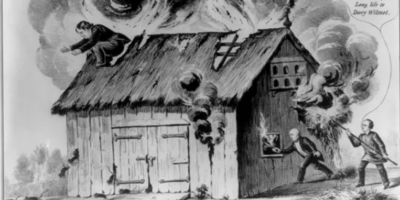The conclusion of a story in three places
By Danny Mayer
On October 14, UK’s student newspaper, the Kentucky Kernel, reported that staff members in the paper’s advertising division had been caught distributing free copies of the paper to guests tailgating at Commonwealth Stadium before the September 18 Cats’ home football game against regional powerhouse Akron University. Originally busted by UK athletics officials for driving “an improperly marked golf cart,” the officers later came back and ordered the staff to cease and desist their unlawful activities: the giving away of free papers to UK sports fans, many of whom were, presumably, alumni, students or kin to alumni or students.
Because it is owned by the state-funded University of Kentucky, Commonwealth Stadium is a public place. However, officials at the school have deemed the free distribution of the Kernel a violation of the public university’s $80 million advertising contract with the privately-owned sports marketing firm IMG College. Neither the Kernel nor the Herald-Leader have reported as of yet on where that $80 million goes: to the university or to the separate UK Athletic Association checking account. Nobody has made clear, that is, whose contract is being honored by explicitly not allowing university students, writing for a university paper, to freely distribute free papers at a football game of their fellow student peers (on a Saturday away from school no less).
But if news outlets nor the university have explicitly answered this question, UK’s actions are pretty clear. During football Saturday’s, the state university grounds surrounding Commonwealth Stadium belong to IMG, which can prohibit the Kernel and other publications from handing out papers on Commonwealth Stadium grounds.
The school and its paper have since come to a measured truce, wherein the Kernel is freely allowed to distribute its free papers…at a set time on gameday and in three designated places around the stadium. Think of it as a Free Journalism Zone, a print version of the school’s ghettoized Free Speech area located at the Student Center, itself a remnant geography from the last constriction of university-owned public space during the late Sixties and early Seventies when administrators aimed to keep those pesky students from hitting the streets between Memorial Coliseum, POT and Kirwan Towers.
To date, I have not located a quote from Lee Todd, the $500,000.00 Man, regarding this sports-centered, student-centered, big/small business-centered debate. Not one word.
This is not to say that Todd has been unwilling to talk sports and students and business. On October 24, ten days after the Kernel broke the Commonwealth/IMG story, the outgoing UK CEO met with the presidential search committee seeking out his replacement, where he stated that “the new UK prez would be wise to retain Mitch Barnhart because he knows how to get the job done,” according to a Wildcat News tweet. The Herald-Leader’s report noted that the UK CEO defined the ideal candidate as one who would want “the whole job,” what he described as a passion for managing fund raising and public image control alongside the competing interests of education, research and business.
“He also said the prospective candidates must deal squarely with the role of Kentucky athletics.They have to have a proper perspective regarding athletics, Todd said. They can’t be a jock, but they can’t say ‘we don’t need it.’ If you do it right […] that is a leverage point you can use in a positive way.” (Italics are mine. The Todd detail was part of a larger article informing us that the next UK president would start negotiations around $700,000, because, in the words of Bill Shelton of the Association of Governing Boards of Universities and Colleges , “we now have presidents hitting close to $1 million.”)
Cheap Side (but not Free Side)
Located several blocks east of Rupp Arena on a square tract of land carved out between Main and Short streets in the midst of the city’s first plotted half-acre “city lots,” Cheapside Park is surely Lexington’s oldest public gathering space still in existence. It sits diagonally across from the city’s oldest commercial district, along Upper Street between Vine and Main on the west side of the CenterPointe block. Its grounds literally surround Lexington’s old city courthouse(s), in use from late 1700s through the end of the last century.
Cheapside more specifically refers to the rectangular area off the west side of the courthouse. By most accounts, the name references an important item in Lexington’s antebellum city market: slaves. This side of the courthouse, its cheap side, was known for its market sales of black bodies down the Ohio and Mississippi Rivers to the notoriously vicious environments of deep south slave plantations. I have seen faded and grainy pictures that show the last slave market ever held there, the entire square filled with people during the city’s market days.
By the early twentieth century, its marketplace capacities diminished, Cheapside had become established as the city’s central gathering grounds for public civic activities like speeches and political rallies for wildly popular politicians. During this time, it also came to be littered with a series of public memorials and historical markers, flanked (and exemplified) most prominently by a pair of immense statues on immenser pedestals commemorating the two great Confederate war chiefs of the area, John C. Breckenridge and John Hunt Morgan.
In January of this past year, the city closed Cheapside Park to renovate it as part of the city’s WEG construction crush. A January 21 Herald-Leader article notes that such renovations would include the $750,000 Fifth Third Pavilion, semi-permeable pavers to reduce storm water runoff, the installation of new storm sewer lines under Cheapside street, and the movement of the iconic statue of Breckenridge, exalted Secretary of War during the last doomed months of the Confederate States, to an even more prominent place next to Main Street. (Not reported in the article, the renovation also included redoing the Main Street sidewalk at its south entrance, and landscaping.)
City leaders point to Cheapside as a successful example of urban design, of the city reclaiming city space for use by the city’s diverse public. Since its re-opening in April, Cheapside has bustled with activity as the new Saturday home of the Lexington Farmer’s Market. With the permanent closing of Cheapside Street, it has also become home to the increasingly popular Thursday Night Live music showcases. Several local bars and restaurants have either re-located near the square or renovated their outside dining space to take advantage of the area’s new public-friendly space. At times, Cheapside actually looks something like the bustling European city-squares our leaders have been creaming over for these past ten years.
And yet, not everyone has benefited from the city’s investments in and refurbishing of the public square. After the renovation and a couple weeks before WEG begins, eight racks holding a variety of Lexington’s free print publications were removed to a small rock-pocked dirt rise facing Short Street and backing up to the backside of the courthouse along the park’s northeast corner. It’s not even really Cheapside, more like East Cheapside, within spitting distance of the hidden historical marker the city put up five years ago to (finally) acknowledge the park’s place in the greater global slave trade.
North of Center was one of these racks moved to the new location, along with Ace, Chevy Chaser, Skirt, a couple jobs magazines and a healthy living magazine. There may have been more, I can’t recall. La Voz may have been there. The Herald-Leader remained unmoved, chained to a telephone pole facing us, down the dirt slope and across the sidewalk.
At the time, I didn’t say much about the forced relocation up the dirt hill to make way for WEGers. I pretty much expected a move for our paper. Our two headlines during WEG, after all, called for a boycott of Spotlight Lexington sponsor Coke, and investigated the temporary downtown homeless shelters in the context of the comparably astronomical city and private monies generated to make WEG a reality. In the words of Mayor Jim Newberry, Lexington was sweeping its front porch, and we were reporting on the dust storm. I was just happy that we weren’t disappeared from Cheapside altogether.
So don’t cry for us. But Lexingtonians drawn to the area around Cheapside, not to mention the few out of town WEGers who ventured downtown, missed bumping into the Chevy Chaser and its regular history column and council person’s report. So too did they miss Ace and its editorials and music calendars. During the entirety of WEG and Spotlight Lexington, both papers sat nearby us, tucked away and out of sight from the city’s most deep-seated public space.
Taken collectively, these free print papers, whose headlines remain out there in the public for 2 to 4 weeks at a time generating untold unique hits a day, provide a somewhat varied guide of area happenings, viewpoints, concerns. To be sure, they are not replacements for more modern online journalism forms, but they remain our most public form of interaction, a compliment to the speed of the internet. Their headlines cannot be formatted to your needs; their slowness allow time for discussion, often in public at public spaces of gathering.
At the long-term local level, print journalism remains a vital—and vibrant—enterprise. It is of course fashionable and easy to shrug it off as a thing of the past, increasingly irrelevant to our current plugged-in everyday lives. But let’s remember that such irrelevancy is not just an inevitable creep. It takes form, follows specific actions. A public university’s football stadium disallows distribution of the school paper to appease the desires of a private corporation to completely manage information on gameday, an act thoroughly supported by the college administration. A public library removes a table bustling with free literature on the grounds it must clear things out. A reclaimed public square eliminates space for its local papers, most of which celebrate the city and its spaces, histories, and people—the very thing local politicians have paid big sums of money to outside consulting firms to try and market and sell.




Leave a Reply